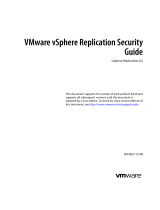
Contents
1 Data Recovery Using VMware And Dell MD Storage Arrays..............................................5
SRM Overview.......................................................................................................................................................... 5
SRA Overview........................................................................................................................................................... 6
2 Setting Up Your Environment.................................................................................................... 7
Installation Prerequisites..........................................................................................................................................7
Compatibility Requirement................................................................................................................................. 7
Remote Replication And Snapshot Premium Feature Activation.......................................................................7
Protected And Recovery Site Installation Requirements...................................................................................8
Dell MD Storage Array Installation Requirements.............................................................................................8
Virtual Disk Layout Considerations...........................................................................................................................8
Setting Up Remote Replication On The MD Storage Array...................................................................................... 9
Host-To-Storage Array Configuration.......................................................................................................................9
Switch Zoning Requirements........................................................................................................................... 10
3 Installing The Recovery Solution Components.................................................................... 11
About This Guide.....................................................................................................................................................11
Summary Of Tasks.................................................................................................................................................. 11
Installing Supported Standalone Database............................................................................................................12
Installing vCenter Server........................................................................................................................................ 12
Installing Site Recovery Manager.......................................................................................................................... 12
Configure an ODBC Connection To Your Standalone Database......................................................................12
Installing SRM On The Protected and Recovery Site...................................................................................... 12
Install The vCenter SRM Plug-in...................................................................................................................... 12
Downloading And Installing The MD Storage Replication Adapter....................................................................... 13
Changing RAID Controller Passwords On The Storage Array......................................................................... 14
4 Configuring The Recovery Solution........................................................................................15
Starting Site Recovery Manager............................................................................................................................ 15
Using vSphere With Site Recovery Manager.................................................................................................. 15
Configuring Site Recovery Manager...................................................................................................................... 16
Connect Recovery And Protected Sites...........................................................................................................16
Set Up Inventory Mappings.................................................................................................................................... 17
Assign Placeholder Datastores.............................................................................................................................. 18
Configuring Storage Array Managers.................................................................................................................... 19
Rescan And Enable The SRAs..........................................................................................................................20
Creating Protection Groups.................................................................................................................................... 21
Creating A Recovery Plan.......................................................................................................................................21




















